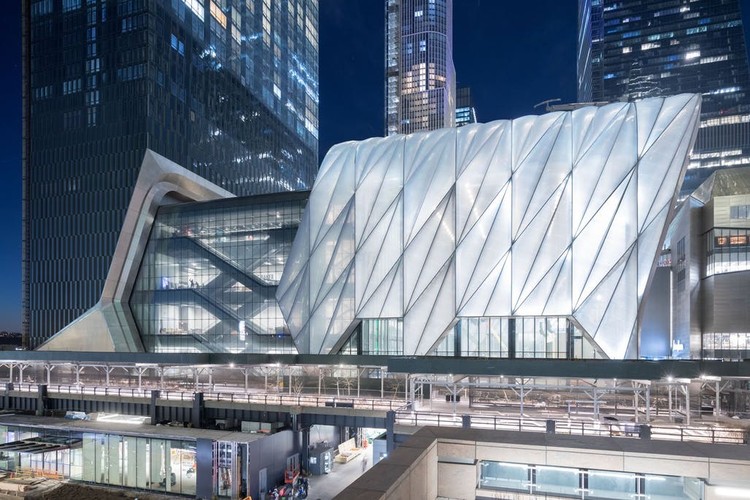
-
Architects: Morris Adjmi Architects
- Area: 52000 ft²
- Year: 2014
-
Manufacturers: Accutrack Systems, Arktura, Dawson Doors, Wausau Window and Wall Systems
-
Professionals: ICO, Lagan, Plant Connection, Sciame Construction




Diller Scofidio + Renfro and Rockwell Group's iconic Shed has opened after more than a decade in the making in New York City. The building features a 120-foot telescopic shell in Hudson Yards that can extend out from the base building when needed for larger performances. Clad in ethylene tetrafluoroethylene (ETFE) “pillows,” the project is connected to the High Line on 30th Street to bring performances and art to the city's newest neighborhood,

New renderings and details of The Shed at Hudson Yards have been revealed as the structure’s ETFE panels continue to be installed ahead of its Spring 2019 opening date.
The new images show how some of the cultural venue’s interior spaces will look, including the galleries and the vast event space created when the wheeled steel structure is rolled out to its furthest extents. This space will be known as “the McCourt,” named after businessman Frank McCourt Jr, who donated $45 million to the project.
Designed by Diller Scofidio + Renfro in collaboration with Rockwell Group, the 200,000-square-foot cultural center was envisioned as a spiritual successor to Cedric Price’s visionary “Fun Palace,” a flexible framework that could transform to host different types of events.

This article was originally published by The Architect's Newspaper as "Ai Weiwei’s fences take on borders and belonging in NYC exhibit."
In Good Fences Make Good Neighbors, a new exhibition by Ai Weiwei presented by the Public Art Fund, the artist and activist takes on the security fence as a medium for urban intervention, with New York City as his canvas. Some of the works might be easy to miss, like the chain link fences suspended over a gap between two buildings on East 7th Street, just steps from Ai’s old basement apartment. But others, like the monumental Gilded Cage at Doris Freedman Plaza in Central Park, or Arch, nested under the Washington Square arch, are unmistakable and grandiose.

Throughout his career, Renzo Piano has designed dozens of museum buildings becoming the most prolific museum designer of our time. Yet, it has been some time since one of his designs has been as widely discussed and analyzed as his latest, the Whitney Museum in New York. In this interview, originally published on The Value of Architecture as "A House for Freedom: an Interview with Renzo Piano," David Plick speaks with Piano about the many inspirations of the Whitney Museum, from the previous Whitney Museum by Marcel Breuer to the neighboring High Line, the city on one side and the river on the other.
Renzo Piano is the great champion of public space. Whether the visitors and citizens of the city are aware of it or not, he improves their quality of life by sharing with them a living space designed specifically for the cultivation and dispersion of ideas and the enrichment of civic life. He’s the architect who cares about the individual’s experience of a building, who cares about how people interact with the space, and how the space then interacts with the world. At the Whitney Museum of American Art, much like the Centre Pompidou, or Beaubourg as he would say, he showed this by including a large area in front—a “piazza” he calls it—for people to meet, congregate, chat, and even loiter. He’s somehow simultaneously innovative and selfless. And because of this, he can masterfully fuse form and function, creating beauty for himself because he loves it and thinks it will save people, yet it all means nothing to him if he can’t share in this emotion with others.
